I Walk the Line: On the Art and Politics of Walking in the City
December 19, 2016 / 0 Comments
I walk a lot. I walk to get from one destination to another. I walk to clear a space in my head. I walk to connect to my neighborhood, to my city, and to those places less familiar. I have never been good at reading a map (or folding one), thus I often let my impressions and senses guide me, or when lost, ask others to point the way.
There is a romance to walking, linked to our need to connect to nature and the physical environment, as well as our will to be alone. However, walking in the city is a profoundly public experience, one that we continually negotiate, and it is through this negotiation that we can better understand the political complexities of public space. Who owns public space? What are the commonly understood rights to its use and access? How does walking both engage and circumvent the spatial order of a city? How does it map new territories of freedom?
For writer Rebecca Solnit, walking is central to urban citizenship and to our participation in public life.
“Walking is only the beginning of citizenship, but through it the citizen knows his or her city and fellow citizens and truly inhabits the city rather than a small privatized part thereof. Walking the streets is what links up reading the map with living one’s life, the personal microcosm with the public macrocosm; it makes sense of the maze all around.” (Note 1)
Walking is also central to several new urban projects that link the pleasure of walking with city revitalization. These include converted rail lines, riverwalks, public promenades and other design projects that advocate for a city’s walkability through creative reuse. Part of the New Urbanism movement, such spaces have become beacons for addressing a whole host of socio-economic issues – diversity and connectivity, alternative transportation routes, sustainable green spaces – with walking as the human action that steers these hybrid landscapes.
Elevated greenways like The High Line in New York and The Bloomingdale Trail in Chicago provide a respite from the daily march on the sidewalk below along with transitory views of the city or a neighborhood where one is suspended between the street and the skyline. This spatial suspension places the walker in both a physical and psychological state of in-between, not just between the sky and the ground or between one entry or endpoint and another, but between nature and urban, past and present, public and private.
The High Line
Reclaiming the industrial ruin as a new infrastructure for nature and leisure has also created new ecologies for art, sites that host and commission a broad range of public projects, from sculptures in situ to temporary installations to billboards to outdoor performances. While not necessarily reinventing public art, these pedestrian parks are catalyzing a new interest in public and spatial art practices, and in the case of The High Line, which courses through Chelsea and delivers one moving south to the steps of the new Whitney Museum of American Art, art is one economic engine driving their development.
I walked The High Line a couple of times during various trips to New York. Once in 2014 when the extension at 34th street or the Rail Yards was just completed, and more recently this past fall. Each time I am taken by the enormity of Manhattan’s cityscape and the sweeping views of the Hudson River, whose watery expanse follows as you wander. I found myself disheartened upon my last visit, however, at the rampant development and new construction that is happening both along the trail and as a byproduct of it; cranes and scaffolding obstruct the magnificent views and hinder easy passage, while jack hammers interrupt the reverie.
The popularity of such parks, along with their narrow paths, large crowds, and cacophony of offerings, including art, and the gentrifying development they generate, has prompted some critics to declare them theme parks. (Note 2)
The High Line as damned by Jerry Saltz:
“The trend I mean is this: toward ersatz, privatized public spaces built by developers; sterile, user-friendly, cleansed adult playgrounds with generic environments that produce the innocuous stupor of elevator music; inane urban utopias with promenades, perches, pleasant embellishments, rest stops, refreshments, and compliance codes.” (Note 3)
Elsewhere in his article, Saltz nonetheless credits the High Line and other similar park developments with ushering in “a new golden age of public art.” I agree for the most part, although my response to the work I have seen on the High Line is rather mixed. Part of this is subjective, of course, and I am limited to what is on view while I am there, but some of the work seems like a new version of plop art, the kind of public sculptures that populated corporate and city plazas in the 1970s, with the High Line as an outdoor showroom for the Chelsea galleries below. Works and exhibitions are curated or commissioned under the auspices of High Line Art, and it is the commissioned works that I have been most drawn to, particularly Barbara Kruger’s recent billboard whose message BLIND IDEALISM IS REACTIONARY, SCARY, DEADLY, installed previous to the November election, became a haunting harbinger to Trump’s dangerous conservatism.
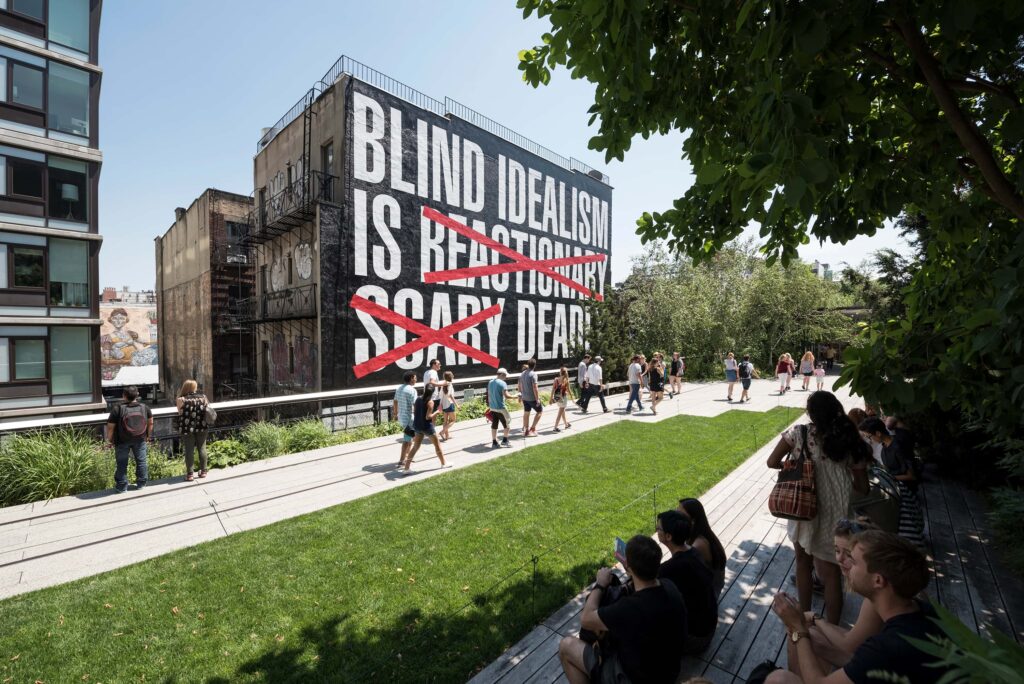
One of the most memorable works I experienced on the High Line remains Spencer Finch’s The River That Flows Both Ways, an homage to the Hudson, which the artist photographed during a 700-minute journey along the river over the course of a single day. Finch then translated the varied palette of the river’s surface captured in his photographs into 700 panes of colored glass installed in a series of grids at the park’s Chelsea Market Passage. For me, this work, on view temporarily and commissioned in partnership with Creative Time, succeeded in its poetic sensitivity to the physical and historical conditions of its site, and should serve as one model for the kind of site responsiveness that public art should aspire to.
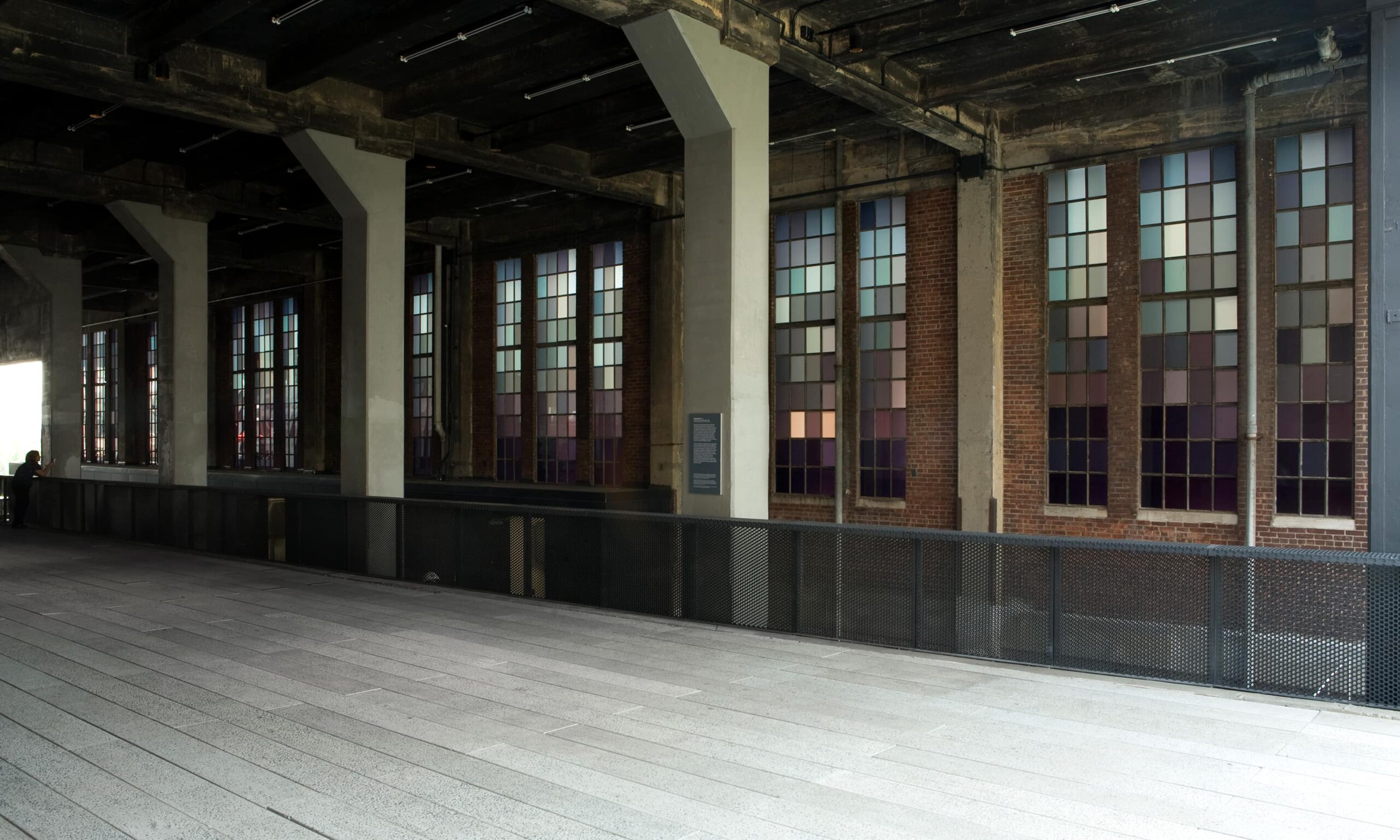
The Bloomingdale Trail
The Bloomingdale Trail, the centerpiece of what is commonly known as The 606, in Chicago is a decidedly more residential adaptive reuse project, an abandoned train line converted to a path for walking and biking that runs straight through 2.7 miles of the city’s west side neighborhoods. Like the High Line, it is the result of a coalition of public and private partners, among them the City of Chicago, the Trust for Public Land, a national nonprofit, and Friends of the Bloomingdale Trail, a volunteer group of community residents. However, its genesis is quite different, as it originated under the city’s Department of Planning and Development to bring more public green space to the neighborhood of Logan Square, including in addition to the converted train line six access parks. The 606 opened in June 2015 and remains a work in progress: plants and trees will fill in as they grow and change with the cycles of the season; additional spaces for public events and gatherings, such as a skate plaza, are planned.
The 606’s art program also differs considerably from High Line Art, with the trail itself conceived and designed as a work of art, one that merges creative engineering, landscape design and expanded definitions of community and public art. Thus less an exhibition space than a cultural space that integrates art and artists throughout the evolution of the site, it accommodates both performance and material art practices, traditional art forms and new, temporary artworks and those that are ongoing. The art program was conceived and guided by Francis Whitehead, a Chicago-based artist whose transdisciplinary work combines environmental advocacy, creative placemaking and collaboration across a broad range of stakeholders to create experiential models of public art. The program’s mission as stated by Whitehead on The 606 website:
“Fully ’embedded’ into the engineering and landscape design team, we have worked collaboratively to synthesize local site conditions with a broad range of contemporary art ideas to form a place-based, experiential approach. The concept that culture and sustainability are deeply linked underpins the arts strategies and creates the ethos of the Arts program, which manifests ‘place’ at multiple scales: local, bioregional, global and virtual. This ‘arts thinking’ has generated plans for several hybrid sites and landscape features across the length of The 606. These ’embedded artworks’ double as park amenities, performance venues or sites for public learning.” (Note 4)
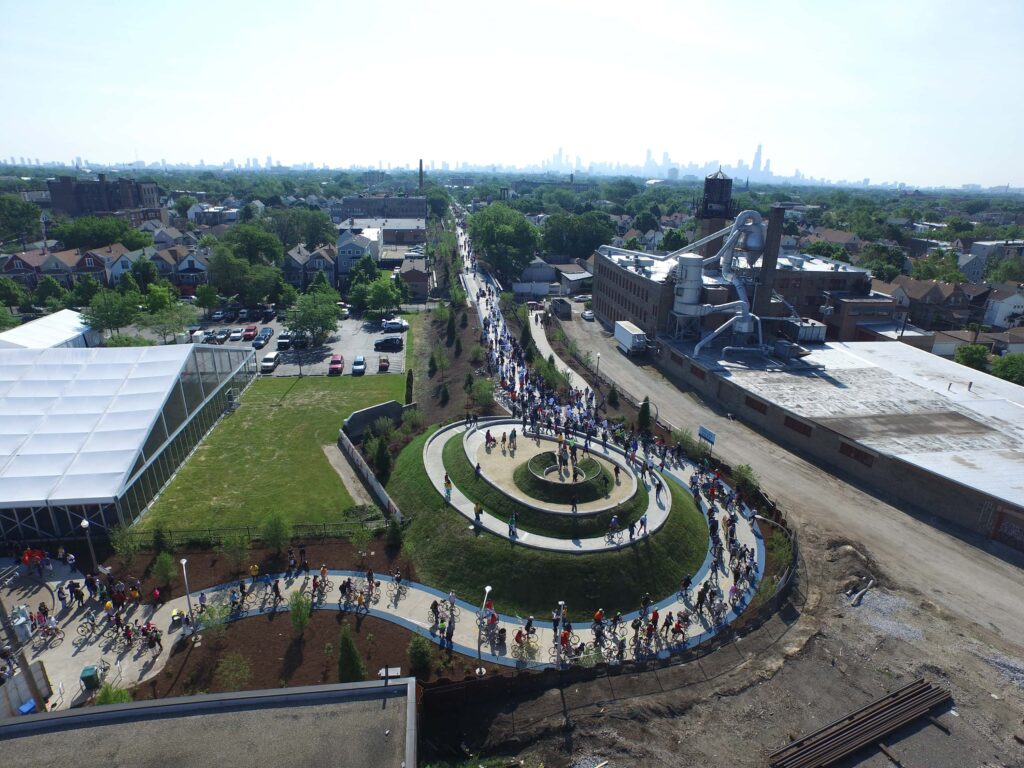
One of these embedded artworks, for example, in an earthwork-observatory at the park’s western trailhead, a mound that offers a raised vantage point to view the sun set then spirals into an OZ-like road that gently leads strollers to the trail. Many of the temporary artworks unveiled upon the park’s opening follow more established models of public art – a billboard by Kay Rosen and a mural series by Louis de Marco – and are no longer on view, while Chakaia Booker’s Brick House, a large serpentine sculpture constructed from the artist’s signature used tires, remains at the trail’s Damen Arts Plaza. Two additional murals have since been installed, and various community processions, such as the now annual Walk with Light and The 606 Soundscape, a weekend soundwalk and listening workshop led by artists, have taken place on the trail.
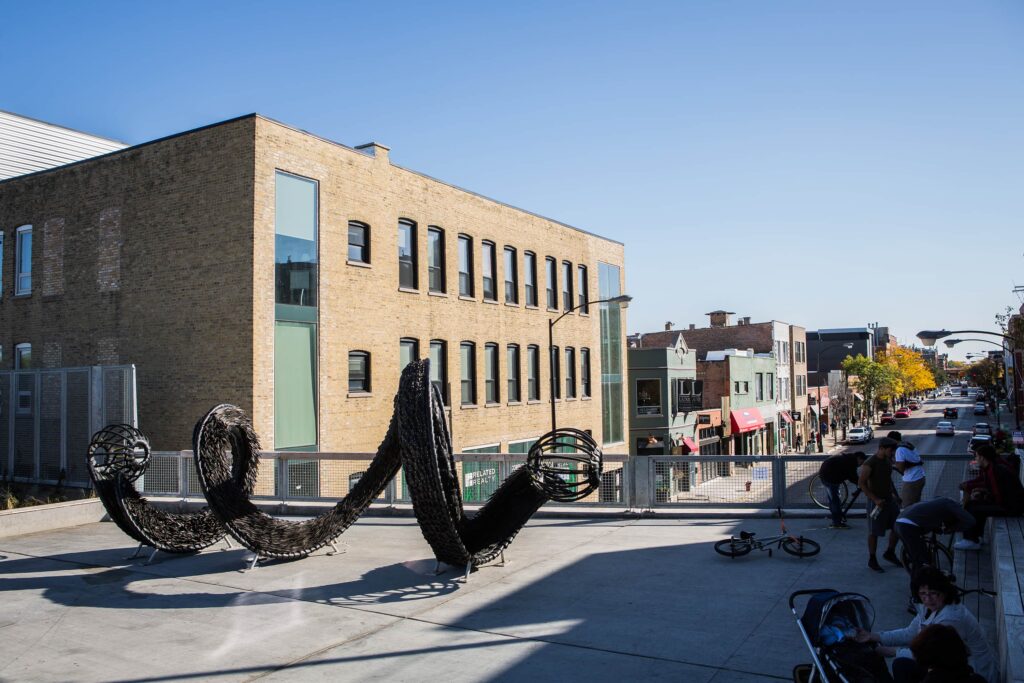
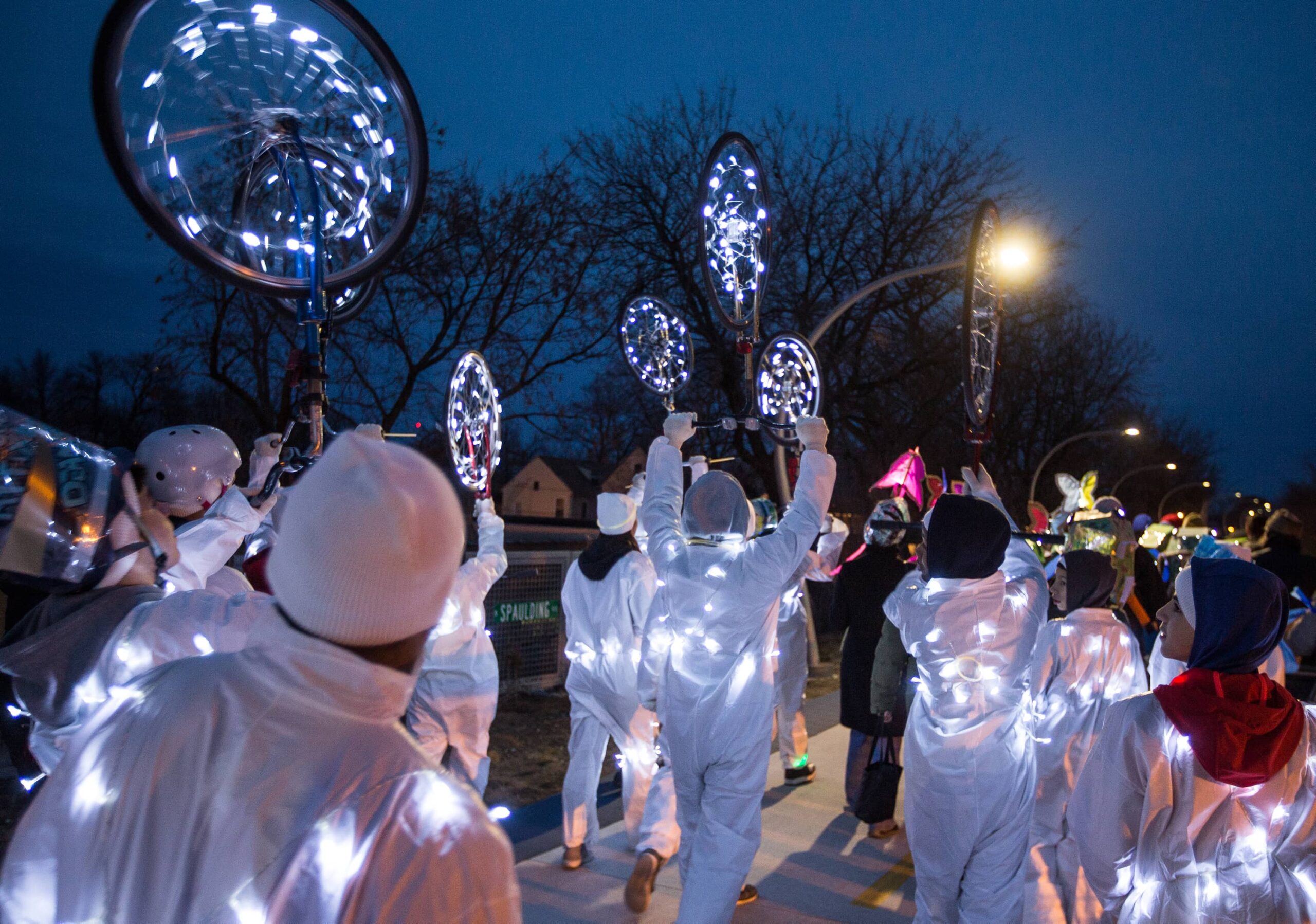
Unlike High Line Art, directed by Friends of the High Line (who also raise private funds to support 98% of the High Line’s operating budget), (Note 5) The 606’s cultural arm is administered by three entities: the Trust for Public Land, The Chicago Park District, and the city’s Department of Cultural Affairs and Special Events. The arts program is still rather nascent and an online campaign is currently underway to raise funds to support future works, including Turning Sky, by the collaborative Luftwerk that will translate weather data into a system of LED lights to illuminate the Milwaukee Avenue bridge.
Walking the Bloomingdale Trail is a study in economic contrasts, in which I often feel like both a trespasser and a voyeur. Depending on which direction one travels or which trailhead one enters, one witnesses a sloping landscape of wealth: less affluent communities, many Latinx, reside near the trail’s west end, while luxury homes and condominiums inhabit the east end. But this uneven development is giving way to increasing property taxes and rising rents at the expense of longtime residents, who last May organized a protest (a militant form of walking) on the trail over concerns that the accelerated gentrification that has followed in The 606’s wake will displace them.
The Desire Path
Such concerns are very real and at the center of the complex labyrinth of issues that these trail parks illicit: the privatization or semi-privatization of public space; gentrification and displacement; city planning overriding community needs and interests. And yet to my mind these elevated greenways are some of the more progressive, certainly largest, public works projects to have emerged over the last decade. With similar projects elsewhere and others underway, now is the time to assess their failures and successes to determine how cities can invest in infrastructure reuse to create healthy public-private-community partnerships that share common goals. Part of this success is to attach public subsidies to these parks that reinvest in the neighborhoods they traverse and that support fair and affordable housing. Art and culture are integral components of such public spaces, with best practices being those that value artists as community members and creative placemakers rather than pawns for real-estate investment. Likewise, Percent for Art ordinances should be broadened to include these trail parks under the rubric of public spaces to ensure that cities support innovative public art and that communities are part of the process. Most importantly, it is imperative that the focus remains on their original mission – to encourage and support walking in the city.
For theorist Michel de Certeau, there is a “rhetoric” to walking in the city, written by ordinary citizens or walkers, “whose bodies follow the thicks and thins of an urban ‘text’ they write without being able to read it.” (Note 6) “The walking of passers-by offers a series of turns (tours) and detours that can be compared to ‘turns of phrase’ or ‘stylistic figures,’” he continues. “The art of ‘turning’ phrases finds an equivalent in an art of composing a path.” (Note 7)
When walking these pedestrian parks, such narratives are often linear and rather scripted, versus those that wind, bend, twist, backtrack or steer off course. These “tours” and “detours” are essential for the return to walking as a form of self-agency, and for creating a kind of “desire path” that is personal and orthogonal. Their straight lines, however, are a given. Instead, delete the political drama, conceive as an exquisite corpse, and above all feed our desire for wanderlust.
Notes
- Rebecca Solnit, “The Solitary Stroller and the City,” Wanderlust: A History of Walking (New York: Viking, 2000), p. 176.
- Nikil Saval, “Uncommon Ground,” New York Times Magazine, November 13, 2016, p. 74.
- See Jerry Saltz http://www.vulture.com/2015/12/how-new-york-solved-the-problem-of-public-art.html. Last accessed December 19, 2016.
- See Frances Whitehead, http://www.the606.org/explore/arts/statement-from-the-leader-artist/.
- See http://art.thehighline.org/about/.
- Michel de Certeau, “Walking in the City,” The Practice of Everyday Life, trans. Steven Rendall (University of California Press, 2011), p. 158.
- Ibid. p. 161.
[…] former industrial sites, including riverfronts, into green spaces. Related to my earlier post about New York’s High Line and Chicago’s 606 – urban revitalization initiatives that transform abandoned rail lines into cultural spaces for […]
[…] I met Kendler at The 606, an adaptive-reuse trailway on Chicago’s near northwest side and the site of her temporary […]
[…] and unique knowledge skills. In her role as lead artist for Chicago’s Bloomingdale Trail (The 606), an adaptive-reuse project that repurposed an abandoned railway into an elevated greenway on the […]